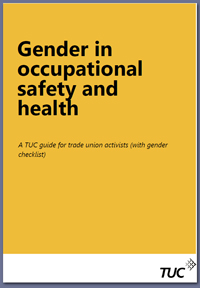The TUC's 2017 guide on gender equality when it comes to addressing the health & safety of workers quite clearly states that people come in all shapes and sizes and when it comes to health and safety, the ‘one size fits all’ approach is old-fashioned and dangerous.
Nowhere is that clearer then when looking at gender. Pressing for healthy, safe workplaces for everyone is part and parcel of the role of health and safety reps and union reps generally and the TUC’s new gender checklist will help reps to pursue issues around gender in the workplace, and make sure that all workers have the best possible protection from illness or injury.
Safety studies show that workers are twice as likely to be seriously injured in a non-unionised workplace where there are no health and safety reps and no health and safety committees to raise and voice concerns, complaints and legal non-compliance so the TUC and all Trade Unions are taking the opportunity to urge any man or woman at work who is worried about their health and safety at work to join a union, to make sure that their concerns are heard and that their interests are protected.
 Some ten years ago, Unionsafety reported on gender issues regarding PPE and that one of the North West BTU Co-ord female USRs (Emma Eldershaw) was involved at national level with new PPE issued which was specifically designed for female engineers.
Some ten years ago, Unionsafety reported on gender issues regarding PPE and that one of the North West BTU Co-ord female USRs (Emma Eldershaw) was involved at national level with new PPE issued which was specifically designed for female engineers.
This was part of the 'learning curve' for BT when it came to providing personal protective equipment for its engineers, which until then, was designed for men with women being expected to use the same equipment, despite clear body shape differences making the use of such equipment uncomfortable and badly fitted; therefore ineffective as far as providing the same level of protection for women as it did for men.
With the support and input from Trade Unions, a lot can be done by employers to ensure that gender bias towards the male, does not hinder the design of female only personal protective equipment, including clothing; which can have a negative affect upon women workers and reduce their safety at work.
Examples of Successful Trade Union Campaigns to ensure that women’s health and safety at work is taken seriously, including:
- Toilets for train drivers: ASLEF campaigned for the proper provision of toilets. Male drivers had endured poor provisions by coping with containers, this was plainly very difficult for female drivers. Station facilities for all staff were upgraded as a result.
- Violence against women: USDAW has run the ‘Freedom from Fear’ campaign for shop workers – who are predominantly women – since 2002, working with major retail employers, the police and politicians to make workplaces safer for all staff and customers.
- Breastfeeding at work: Unite took up cases of cabin crew members who were new mothers whose employer’s rostering was not compatible with their need to breastfeed their babies. This case confirmed working women’s right to continue breastfeeding after returning to work and obligation on employers to accommodate this.
- Dangerous Dogs: CWU fought a 7-year campaign to change the Dangerous Dogs Laws in the UK and their ‘Bite-Back’ campaign achieved new strengthened legislation to protect postal and telecom workers. The new laws now apply everywhere in England, Scotland, Wales and Northern Ireland and also carries far tougher sentences and a wider range of enforcement powers for police. Thousands are attacked annually including many women.
 The Guide entitled “Gender in occupational health and safety” says that historically the health and safety needs of men in the workplace have been prioritised over women. Risk prevention has focused on visibly dangerous work – largely carried out by men – in industries like construction and mining, with an assumption that the kind of work that women do is safer. The Guide was developed by the TUC’s Gender and Occupational Safety & Health Group and TUC Health and Safety Specialists Committee input.
The Guide entitled “Gender in occupational health and safety” says that historically the health and safety needs of men in the workplace have been prioritised over women. Risk prevention has focused on visibly dangerous work – largely carried out by men – in industries like construction and mining, with an assumption that the kind of work that women do is safer. The Guide was developed by the TUC’s Gender and Occupational Safety & Health Group and TUC Health and Safety Specialists Committee input.
However, the guidance argues that a gender-stereotyped or the ‘one size fits all’ approach is now out-of-date. It has been issued in line with the theme chosen for the 2017 International Workers’ Memorial Day in April, the theme of which was ‘good health and safety for all workers – whoever they are’.
Where the differences between men and women are taken into account when assessing risk and deciding suitable risk control solutions, there is a greater chance of ensuring that the health, safety and welfare of all workers is protected.
The new guide outlines some of the main health and safety risks women can face at work:
- Back pain: Women tend to suffer more from pain in the upper back and limbs as a result of repetitive work in both manufacturing and offices, while men tend to suffer more from lower-back pain from exerting high force at work.
- Violence and harassment: Women tend to work in lower-paid and low-status jobs where bullying and harassment are more common, while men predominate in better-paid, higher status jobs and supervisory positions.
- Not having the right tools: Women working in male professions like construction, engineering and the emergency services are at risk from inappropriately designed tools.
The handbook also provides an important “Checklist” for health and safety representatives and union representatives generally to help them pursue issues around gender at work – including questions about whether sex and gender differences are taken into account in manual handling risk assessments, and in assessments of postural problems including prolonged standing or sitting.
It’s hoped that the findings will help union reps encourage employers to take action on the issues that will make a real difference to the health, safety and welfare of women in their workplaces.
The guide can be downloaded from the unionsafety E-Library
Source: TUC / CWU H&S Dept / Dave Joyce


 Some ten years ago, Unionsafety reported on gender issues regarding PPE and that one of the North West BTU Co-ord female USRs (Emma Eldershaw) was involved at national level with new PPE issued which was specifically designed for female engineers.
Some ten years ago, Unionsafety reported on gender issues regarding PPE and that one of the North West BTU Co-ord female USRs (Emma Eldershaw) was involved at national level with new PPE issued which was specifically designed for female engineers.